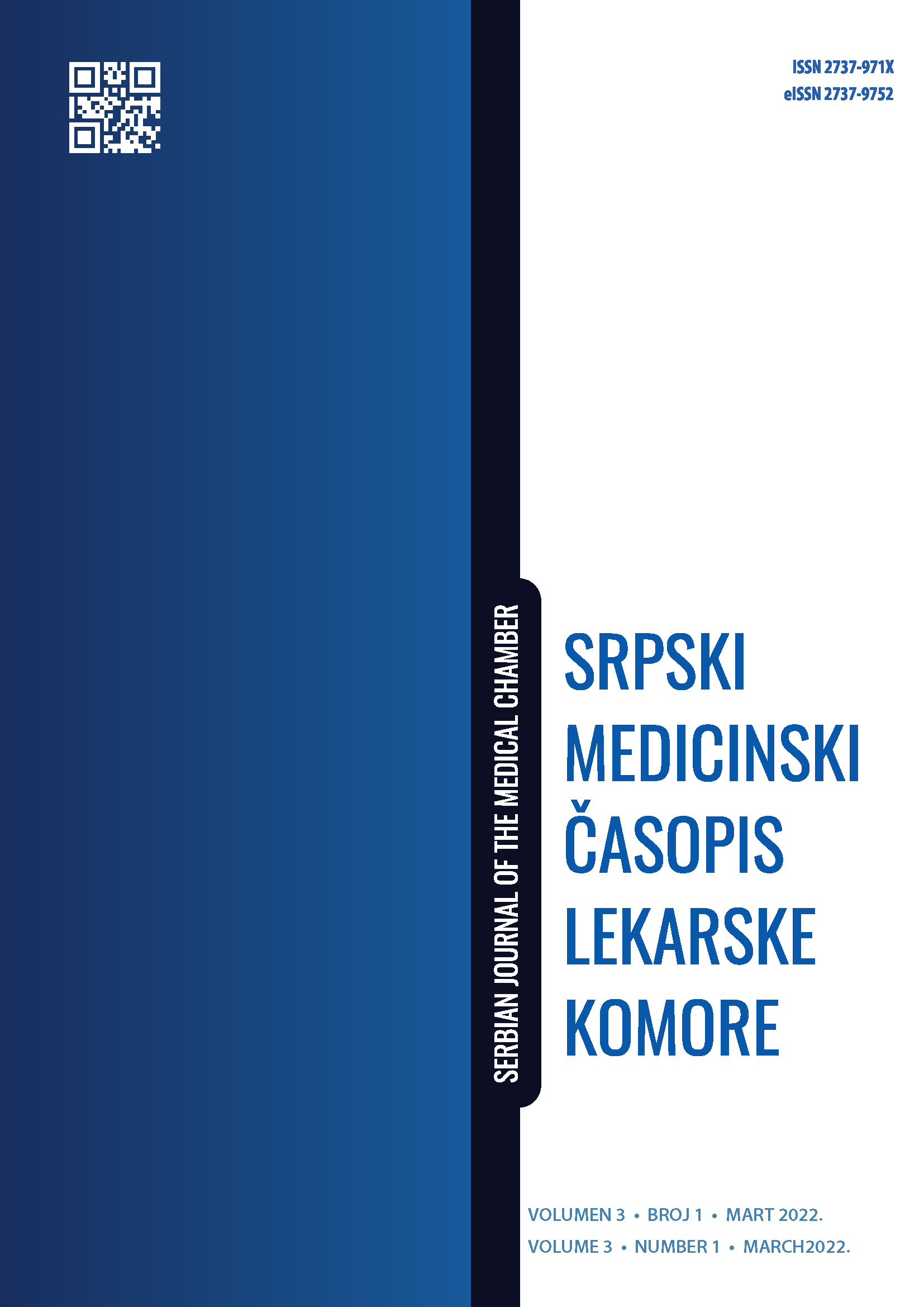BAKTERIJSKE INFEKCIJE KOD BOLESNIKA U PROGRAMU ALOGENE TRANSPLANTACIJE KOŠTANE SRŽI
Sažetak
Uvod: Bakterijske infekcije su česte među bolesnicima u programu alogene transplantacije matičnih ćelija hematopoeze. Infekcije su najčešći uzrok oboljevanja i umiranja transplantiranih pacijenata. Najčešći patogeni su bakterije Staphylococcus i Enterobacteriaceae, koje izazivaju približno po 25% bakterijskih infekcija, a prate ih Enterococcus i P. aeruginosa.
Cilj: Cilj rada jeste određivanje učestalosti bakterijskih infekcija kod pacijenata u programu alogene transplantacije matičnih ćelija hematopoeze, na Klinici za hematologiju Univerzitetskog kliničkog centra Srbije, kao i određivanje epidemiološke situacije, učestalosti različitih oblika kliničke slike bakterijskih infekcija i njihovog uticaja na preživljavanje.
Materijali i metode: U retrospektivnu kohortnu studiju uključeno je 58 bolesnika. Prisustvo bakterija određivano je standardnom bakteriološkom kultivacijom iz uzoraka. Dijagnoza lokalizovane bakterijske infekcije donosi se na osnovu postojanja karakterističnih kliničkih znakova, uz bakteriološku potvrdu. Klinička dijagnoza sepse postavlja se na osnovu pozitivne hemokulture i postojanja sistemskog inflamatornog odgovora. Lečenje bakterijske infekcije počinje se empirijski, a nastavlja antibioticima po antibiogramu. Preživljavanje bolesnika analizirano je Kaplan-Majerovom metodom i upoređivano uz pomoć log-rank testa.
Rezultati: Bakterijske infekcije su se javile kod 15 (25,9%) pacijenata. Najčešći izazivači su bile Gram-negativne bakterije (65,2%). Najčešća klinička slika je bila sepsa (59,0%). Letalitet od bakterijskih infekcija je bio 60,0%. Na osnovu Kaplan-Majerove krive, medijana preživljavanja bez bakterijskih infekcija je iznosila 106,0 meseci (95% CI 85,2 – 163,3), dok je za pacijente sa bakterijskim infekcijama iznosila 14,0 (95% CI 8,9 – 19,1). Log-rank testom uočena je značajna statistička razlika u preživljavanju ove dve grupe (p < 0,001). Pseudomonas spp. je bio osetljiv na kolistin i/ili meropenem. Klebsiella pneumoniae je bila osetljiva je na kolistin.
Zaključak: Bakterijske infekcije su česte na našoj klinici, izazvane su bolničkim i endogenim oportunističkim bakterijama. Prevenciju ovih infekcija treba usmeriti ka merama prevencije bolničkih infekcija.
Reference
- Fishman JA. Infection in solid-organ transplant recipients. N Engl J Med 2007;357(25):2601–14
- Wingard JR, Hsu J, Hiemeny JW. Hematopoietic stem cell transplantation an overview of infection risk and epidemiology. Infect Dis Clin North Am 2010;24(2):257–72.
- Tahuanty Pena, MD, MS, Julia Klesney-Tait, MD, PhD. Mycobacterial Infections in Solid Organ Hematopoietic Stem Cell Transplantation. Clin Chest Med. 2017 Dec;38(4):761-770.
- Kedia S, Acharya PS, Mohammad F, Nguyen H, Asti D, Mehta S et al. Infectious
complications of hematopoietic stem cell transplantation. J Stem Cell Res Ther
2013;S3:002 - Balletoo, M. Mikulska. Bacterial Infections in Hematopoietic Stem Cell Transplant Recipients. Mediterr J Hematol Infect Dis 2015 Jul 1;7(1):e2015045
- Helebi C, Akan H, Akc¸aglayan E, et al. Febrile neutropenia in allogeneic and
autologous peripheral blood stem cell transplantation and conventional chemotherapy for malignancies. Bone Marrow Transplant 2000;26:211 - Boucher HW, Talbot GH, Bradley JS, et al. Bad bugs, no drugs: no ESKAPE! An
update from the Infectious Diseases Society of America. Clin Infect Dis 2009; 48 (1):
1–12 - Mikulska M, Del Bono V, Viscoli C. Bacterial infections in hematopoietic stem cell
transplantation recipients. Curr Opin Hematol 2014; 21 (6): 451–458. - O Zając-Spychała1, J Wachowiak 2, A Pieczonka 2, K Siewiera 3, J Frączkiewicz 3, K Kałwak 3et all. Bacterial infections in pediatric hematopoietic stem cell transplantation recipients: incidence, epidemiology, and spectrum of pathogens: report of the Polish Pediatric Group for Hematopoietic Stem Cell Transplantation. Transpl Infect Dis. 2016 Oct; 18(5):690-698.
- Julien Coussement1, David Lebeaux, Claire Rouzaud, Olivier Lortholary. Nocardia infections in solid organ and hematopoietic stem cell transplant recipients. Curr Opin Infect Dis. 2017 Dec;30(6):545-551.
- Dan Feng1, Yong-Tian Zhang 1, Ting-Ting Qiu 2, Kai-Lin Xu 3. Clinical Features of Infection within 100 days after Hematopoietic Stem Cell Transplantation in 313 patients with Hematologic Diseases. Zhongguo Shi Yan Xue Ye Za Zhi. 2020 Apr;28(2):602-608.
- Gustinetti G, Mikulska M. Bloodstream infections in neutropenic cancer
patients: a practical update. Virulence 2016;7:280e97 - Meera Mohan1, Sandra Susanibar-Adaniya 1, Amy Buros 1, Juan Carlos Rico Crescencio 2, Mary J Burgess 3 et all. Bacteremias following autologous stem cell transplantation for multiple myeloma: Risk factors and outcomes. Transpl Infect Dis. 2019 Apr;21(2)e13052.
- Rosa RG, Dos Santos RP, Goldani LZ. Mortality related to coagulase-negative staphylococcal bacteremia in febrile neutropenia: A cohort study. Can J Infect Dis Med Microbiol
- Shaw BE, Boswell T, Byrne JL, Yates C, Russell NH. Clinical impact of MRSA in a stem cell transplant unit: analysis before, during and after an MRSA outbreak. Bone Marrow Transplant2007; 39:623-9.

